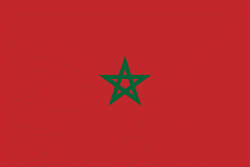Laâyoune-Boujdour-Sakia El Hamra (Laâyoune-Boujdour-Sakia El Hamra)
 |
The region was bordered to the east by the region of Guelmim-Es Semara. To the south was the region of Oued Ed-Dahab-Lagouira, entirely within the Western Sahara. The east of the region bordered the Mauritanian region of Tiris Zemmour. Laâyoune-Boujdour-Sakia El Hamra had a coastline on the Atlantic Ocean, facing the Spanish Canary Islands.
The region consisted of the following provinces:
* Boujdour Province
* Laâyoune Province
* Tarfaya Province
Map - Laâyoune-Boujdour-Sakia El Hamra (Laâyoune-Boujdour-Sakia El Hamra)
Map
Country - Morocco
 |
 |
| Flag of Morocco | |
In a region inhabited since the Paleolithic era over 300,000 years ago, the first Moroccan state was established by Idris I in 788. It was subsequently ruled by a series of independent dynasties, reaching its zenith as a regional power in the 11th and 12th centuries, under the Almoravid and Almohad dynasties, when it controlled most of the Iberian Peninsula and the Maghreb. In the 15th and 16th centuries, Morocco faced external threats to its sovereignty, with Portugal seizing some territory and the Ottoman Empire encroaching from the east. The Marinid and Saadi dynasties otherwise resisted foreign domination, and Morocco was the only North African nation to escape Ottoman dominion. The 'Alawi dynasty, which rules the country to this day, seized power in 1631, and over the next two centuries expanded diplomatic and commercial relations with the Western world. Morocco's strategic location near the mouth of the Mediterranean drew renewed European interest; in 1912, France and Spain divided the country into respective protectorates, reserving an international zone in Tangier. Following intermittent riots and revolts against colonial rule, in 1956, Morocco regained its independence and reunified.
Currency / Language
| ISO | Currency | Symbol | Significant figures |
|---|---|---|---|
| MAD | Moroccan dirham | د م. | 2 |
| ISO | Language |
|---|---|
| AR | Arabic language |
| FR | French language |















